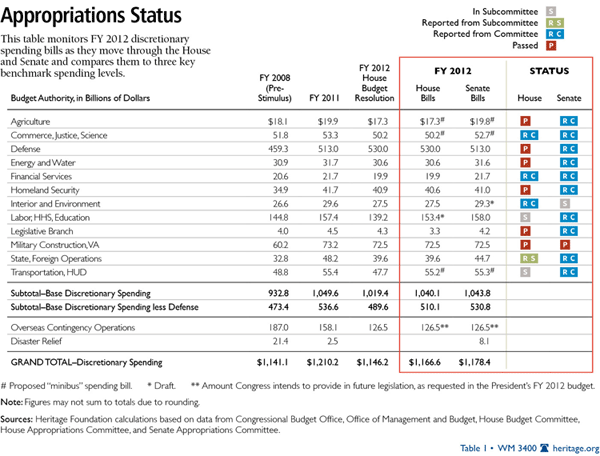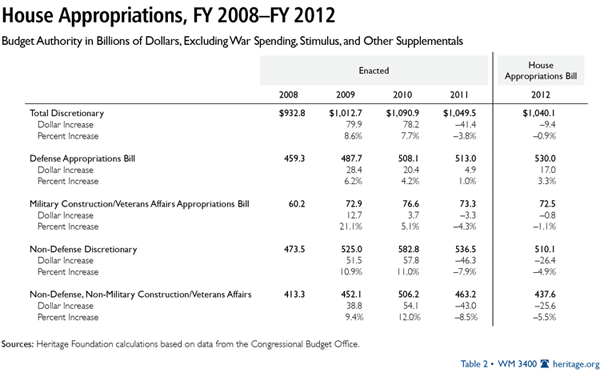While most attention is focused on the congressional “super committee,” House and Senate appropriators have been moving legislation aimed at meeting their own fiscal year (FY) 2012 spending limits under the debt reduction agreement enacted earlier this year. So far, the appropriators are close to that modest goal. But they are far from returning to the pre-stimulus, pre-bailout levels they should be striving for, and their spending bills also exceed the House budget resolution level—the absolute minimum they should try to achieve.
Progress to Date
In the House, the 12 appropriations bills total $1.04 trillion in non-emergency, non-war budget authority. That is about $3 billion below the $1.043 trillion overall cap level in the debt ceiling agreement’s Budget Control Act (BCA), and includes a $17 billion increase for defense compared with FY 2011, as shown by the Heritage Appropriations Tracker.[1] (See Table 1.) But the total figure is $107 billion above the FY 2008 base discretionary spending level and $21 billion over that of the House-passed budget resolution.
Senate appropriators are even farther from an acceptable mark, with their spending bills exceeding even the BCA cap by nearly $1 billion. Worse, their defense bill provides just $513 billion in budget authority, a freeze at the FY 2011 level. The Senate should cut other bills further so it can at least match the House defense funding level. But even with that, total Senate appropriations, like those in the House, will remain well in excess of the acceptable 2008 benchmark and the House budget level.
Real Spending Cuts, but Not Deep Enough
The 112th Congress has taken worthy steps toward reversing the relentless spending surge of 2009–2010. The full-year continuing resolution for FY 2011 reduced total discretionary spending by 3.8 percent and non-defense discretionary by nearly 8 percent. (See Table 2.) These were real, year-to-year cuts, not merely reductions from an inflated baseline projection—a rare event in federal spending.
Still, the $46 billion non-defense reduction in 2011 represents only about 1.3 percent of total federal spending for that year and includes a 4.3 percent cut in the Military Construction/Veterans Affairs appropriation. This is noteworthy because military construction is part of overall national defense spending (function 050 of the budget), and Veterans Affairs discretionary spending is mainly veterans’ health care.
Further, appropriators have made relatively minor trims in existing government programs; they have so far avoided fundamentally reassessing government priorities, which will be needed to get the government’s fiscal house in order for the long run.
That is one reason appropriators should continue driving for the 2008 non-defense discretionary spending level.[2] If they cannot manage that, they should at least get total discretionary budget authority down to no more than the House-passed budget resolution level of $1.019 trillion (excluding war spending). There are other reasons as well.
Defense in Jeopardy. The crippling defense spending cuts that could result from the BCA[3] would follow already tight spending limits that have been imposed on the Pentagon. The defense appropriation for FY 2011 provided an increase in base spending (excluding war funds) of just 1 percent (see Table 2), and the House appropriators’ 2012 defense bill would boost funding by only 3.3 percent.
In an additional complication, both House and Senate appropriations appear to exceed the BCA’s limit for “security” funding, a category that covers activities well beyond defense.[4] Consequently, national defense—the most basic federal responsibility—will continue to be dangerously squeezed unless Congress pursues a bold realignment of other government responsibilities. This should entail devolving lower-priority activities to state and local governments and the private sector, where they belong. Beyond that, Congress should cut away unnecessary or obsolete programs. The opportunities are plentiful.[5]
BCA Spending Grows After 2012. Though the BCA limits require real spending cuts in 2012, the caps rise after that, allowing spending to grow (albeit it at a rate lower than inflation). By 2021, base discretionary budget authority would be more than $300 billion (about 32 percent) higher than it was in 2008 and almost $185 billion higher than it is today. With federal government debt currently approaching three-fourths the size of the entire economy, further non-defense discretionary cuts are still necessary.
Total Outlays Driving Unsustainable Debt. Even excluding the failed $825 billion stimulus experiment, Congress and the President pumped up non-defense appropriations by double-digit percentages in 2009 and 2010, and this spending is in dire need of restraint. Yet total discretionary spending is just slightly more than one-third of the budget. The biggest budget driver in the future comes from so-called “mandatory” spending on the major entitlements: Medicare, Medicaid, and Social Security. Spending on these programs alone is projected to soar from today’s 10.3 percent of gross domestic product (GDP) to 18.2 percent in 2050.
These programs, combined with discretionary spending, will run up debt in excess of 300 percent of GDP over that same time horizon. This makes it all the more imperative that Congress boldly reduce discretionary spending and move on to tackle the entitlement programs.
An Economic Millstone. The notion that government deficit spending can drive economic growth has been thoroughly discredited over the past two-and-a-half years. Government spending of all varieties is a dead-weight burden on the economy and is surely holding back growth. To unleash the economy’s potential, Congress should limit all spending to activities that are truly necessary and are priorities of the federal government. Bold solutions to the entitlement crisis are indispensable, but further restraint of discretionary spending remains necessary as well.
Seize the Moment
The 112th Congress has moved toward getting control of spending, with real cuts enacted in FY 2011 and a bold House budget resolution that charts a new course for fiscal policy. The flawed BCA, wrought from the summer-long debate over the debt ceiling, does call for further real cuts in discretionary budget authority in FY 2012, but after that, it allows spending to rise again, drifting further from the proper goal of pre-stimulus, pre-bailout levels. It is backed up by a crude enforcement mechanism that would not take effect until January 2013 and could very well be dismantled by then, given its blunt force nature. Thus, the most important objective of the summer’s debt ceiling confrontation—to start getting runaway government spending under control—could be lost.
Therefore, congressional appropriators should not settle for the inadequate spending limits in the BCA. The principal goal is not merely to meet a target but to restore balance in fiscal policy and to return the federal government to its proper, and limited, role.
Patrick Louis Knudsen is the Grover M. Hermann Fellow in Federal Budgetary Affairs in the Thomas A. Roe Institute for Economic Policy Studies at The Heritage Foundation.



